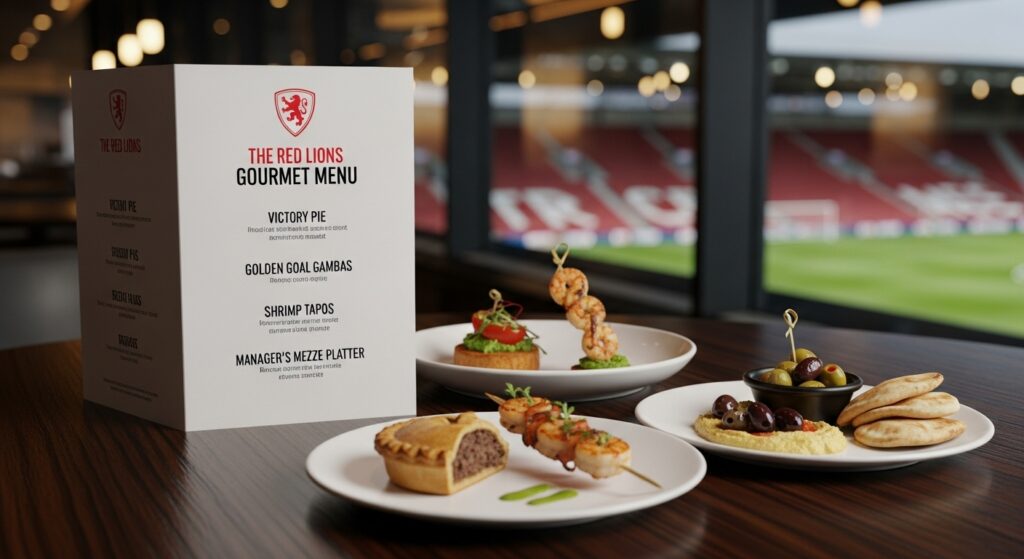In today’s dynamic world of sports, a football club menu is no longer just about serving quick bites to fans in the stands. Instead, it has become a strategic extension of a club’s identity, reflecting its culture, values, and commitment to fan experience. From classic stadium favorites to gourmet dining options and community-driven initiatives, the most innovative clubs are redefining what it means to enjoy food as part of the matchday atmosphere.
This article explores the evolving role of the football club menu, the balance between tradition and innovation, and how culinary choices are shaping the future of fan engagement.
What Is a Football Club Menu?
A football club menu refers to the curated food and beverage offerings available at a club’s stadium, hospitality lounges, or affiliated venues. Historically, this meant burgers, hot dogs, and soda—a quick fix for fans eager to return to their seats. Today, however, the football club menu has transformed into a carefully designed experience that reflects modern tastes, dietary needs, and cultural trends.
For clubs worldwide, the menu is more than just a list of meals—it’s a storytelling tool. It allows clubs to showcase local flavors, celebrate traditions, and align with health, sustainability, and inclusivity values.
Tradition Meets Innovation
At the heart of every football club menu is the balance between honoring beloved traditions and embracing new culinary ideas.
-
Classic Fan Favorites: Staple items such as pies in England, bratwurst in Germany, or empanadas in South America remain essential. These foods connect fans to decades of heritage and nostalgia.
-
Modern Culinary Trends: Clubs are introducing gourmet burgers, craft beers, vegan hot dogs, and gluten-free options to meet the needs of health-conscious and diverse audiences.
-
Local Identity: Some menus spotlight regional delicacies to strengthen the bond between the club and its community. For example, a Catalan football club may highlight tapas, while a Texan club embraces barbecue flavors.
The best menus strike a perfect balance—preserving tradition while evolving with the times.
The Role of Sustainability in Football Club Menus
Sustainability has become a defining factor in modern football club menus. Fans today want more than tasty meals—they want ethical and eco-friendly practices. Leading clubs are adopting strategies such as:
-
Locally Sourced Ingredients: Reducing carbon footprints while supporting local farmers.
-
Plant-Based Options: Expanding vegan and vegetarian choices to encourage healthier and sustainable diets.
-
Zero Waste Initiatives: Composting food scraps, reducing single-use plastics, and donating unsold meals to community programs.
These sustainable practices not only benefit the planet but also strengthen a club’s image as a socially responsible organization.
Football Club Menus and Fan Engagement
A well-curated football club menu is a powerful engagement tool. Food is part of the matchday ritual, and great culinary experiences enhance fan loyalty. Some examples include:
-
Interactive Experiences: Mobile apps allow fans to pre-order meals, avoiding long queues and increasing convenience.
-
Themed Items: Clubs often launch special menu items to celebrate rivalries, anniversaries, or victories—making food part of the club’s narrative.
-
Community Involvement: Inviting local chefs or partnering with neighborhood eateries gives fans a sense of ownership and pride.
By aligning the football club menu with fan identity, clubs transform mealtime into a shared cultural celebration.
Hospitality and Premium Dining
Beyond the general stands, football clubs are also elevating menus in VIP lounges and hospitality suites. These experiences redefine the football club menu as not just a convenience but a luxury:
-
Gourmet Dining: Michelin-star chefs designing multi-course meals for hospitality guests.
-
Wine and Craft Beer Pairings: Offering curated drink menus to complement dishes.
-
Cultural Fusion Cuisine: Reflecting international audiences by blending global flavors.
These premium menus serve two purposes: they cater to elite fans and corporate sponsors while also elevating the overall prestige of the club.
Digital Influence on the Football Club Menu
In today’s digital age, football clubs understand the role of online presence in promoting their menus. Social media platforms are filled with photos of fans enjoying unique stadium dishes, turning meals into shareable moments. Clubs now:
-
Launch Instagram-worthy food items designed to trend online.
-
Promote limited-time menu collaborations with local food brands.
-
Use QR codes and apps for interactive ordering and menu customization.
By leveraging digital platforms, the football club menu becomes more than a stadium staple—it becomes a marketing tool that extends far beyond matchday.
Catering to Global Fans
Football is a global sport, and clubs increasingly tailor their menus to international visitors. This includes:
-
Halal and Kosher Options: Ensuring inclusivity for diverse religious groups.
-
Allergen-Friendly Dishes: Clearly labeling gluten-free, dairy-free, and nut-free options.
-
Cultural Representation: Offering international street foods that celebrate the global nature of football fandom.
These efforts allow fans from around the world to feel seen, included, and valued.
Challenges in Designing a Football Club Menu
Despite its potential, creating an effective football club menu comes with challenges:
-
Maintaining Affordability: Ensuring prices remain accessible to all fans.
-
Balancing Speed and Quality: Serving tens of thousands of fans quickly without sacrificing taste.
-
Managing Logistics: Coordinating large-scale catering operations while maintaining consistency.
Clubs that succeed view these challenges as opportunities for innovation, using technology and partnerships to streamline operations.
A Model for the Future
The evolution of the football club menu reflects broader changes in sports culture. No longer just an afterthought, menus are now central to creating a holistic fan experience. They showcase identity, promote sustainability, and build deeper connections between clubs and communities.
As expectations continue to grow, the football club menu will likely evolve further—integrating advanced tech, personalized nutrition, and even immersive dining experiences linked to augmented reality.
Conclusion
The modern football club menu is more than food—it’s a reflection of a club’s values, identity, and vision for the future. From traditional pies and beers to plant-based gourmet meals and digital innovations, clubs are reimagining how fans experience food as part of the game.
By combining tradition with innovation, sustainability with inclusivity, and community with global reach, the football club menu has become an essential ingredient in shaping unforgettable matchday experiences.
For fans, this evolution means that supporting a club is no longer just about the 90 minutes of football on the pitch—it’s about the taste, culture, and shared memories that surround it.






